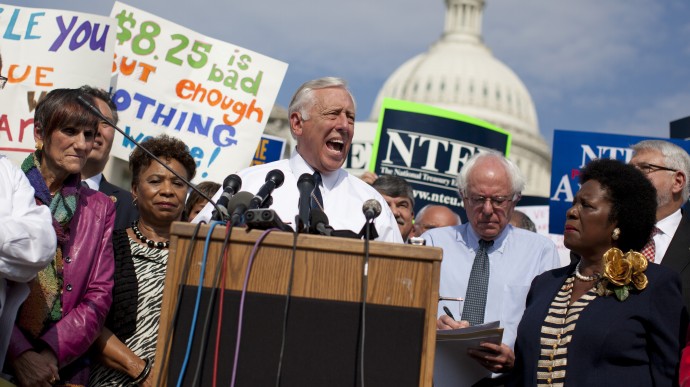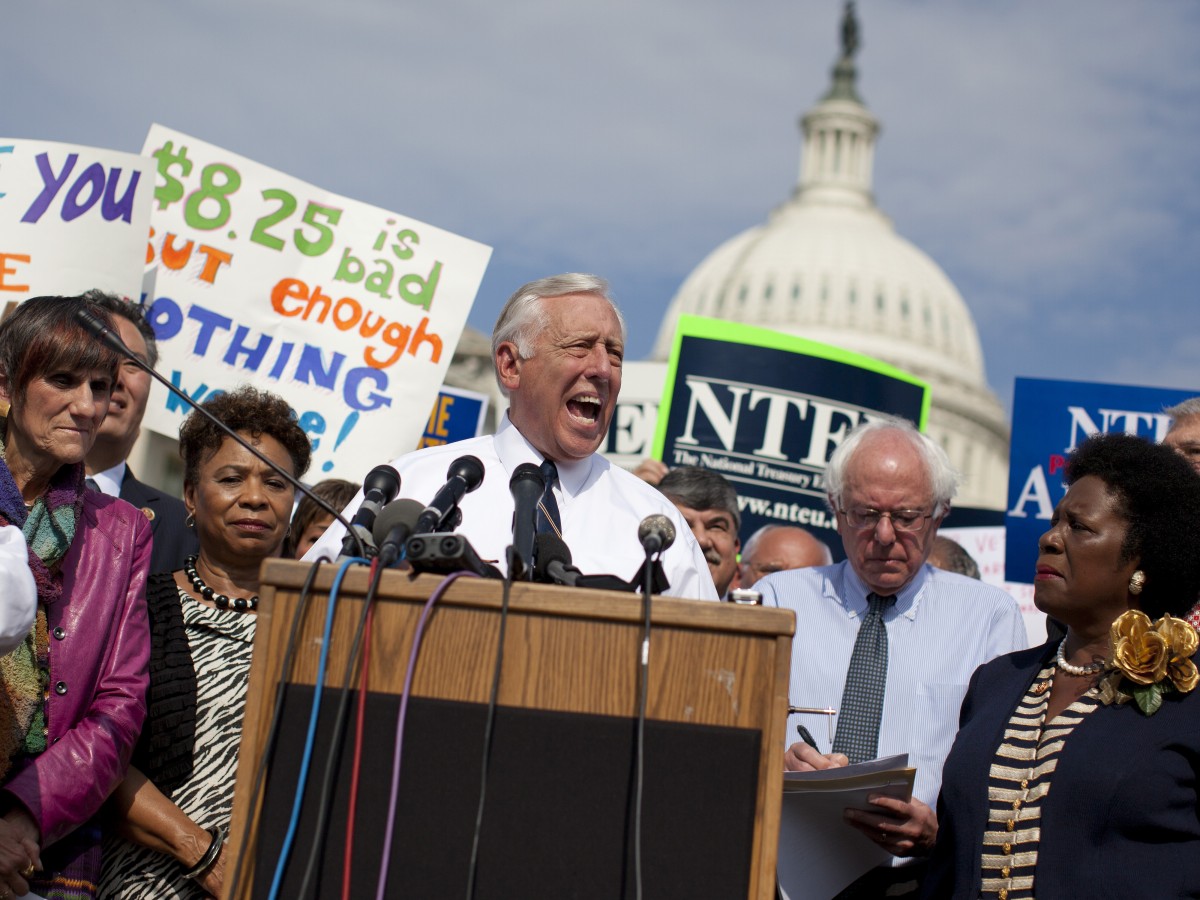
On Thursday, Texas Sen. Wendy Davis (D-Fort Worth) confirmed weeks of speculation when — on the stage where she received her high school diploma, Wiley G. Thomas Coliseum — she announced her intention to become the 48th governor of Texas.
“This is a campaign not just for governor but for the very future of our state,” the 50-year-old said. “Thirty-two years ago, I started my own journey in this room. Today, we start a new journey — together. It’s a journey that won’t end on Election Day, and it won’t end in Austin. As long as we can make our great state even greater, we will keep going.”
Davis came into national prominence when she conducted a 21-hour speaking filibuster that successfully postponed a vote on abortion clinic limitations in the state of Texas. Despite the fact the legislation passed in a subsequent special legislative session, the ordeal made the formerly obscure legislator into a national progressive star in something of a real-life “rags-to-riches” success story.
Interestingly enough, in a state where no Democrat has won statewide executive office since 1994, Davis stands more than a fighting chance. With Gov. Rick Perry (R) not seeking re-election, Republican frontrunner Greg Abbott, the current state attorney general, leads Davis by eight points in the polls. In this deeply red state, with more than half of a year before the primaries and with polls showing 50 percent of the populace undecided, that’s almost a statistical tie. As such, this election is shaping up to be the most expensive and closely watched in modern Texas history.
Thirty-six states will be voting for governor in 2014. For the Republicans, 2014 will be an essential year. As their presence in the federal government continues to wane, the Republicans maintain relevance through the 30 governorships the party currently holds. Through this control of the states’ executive branches, the Republicans also maintain control of redistricting — giving the party an advantage in House races — and control of the states’ agendas, which can potentially give a pro-Republican bias to the political environment, as seen with North Carolina’s wide suite of voting reforms.
“2014 is going to be a referendum on many of the tea party governors who got swept into office in 2010,” said Vermont Gov. Pete Shumlin (D). “I really feel there will be a national message, which will be frustration from voters who thought they were getting job creators but instead got zealots for tea party ideology.”
Many of the key presidential swing states — including Florida, Iowa, Nevada, Ohio, Pennsylvania and Wisconsin — will hold gubernatorial elections in 2014, which could help define the 2016 and 2020 elections. In light of this, it is expected that the Democrats will nationalize the governor races, tying state-level Republicans to the national Republicans, who are being blamed for increasing partisanship in Congress and the current federal government breakdown.
More than a year ahead of the elections, the Democrats are poised to lose one state — Arkansas — while the Republicans are poised to lose Florida, Maine, Michigan, Ohio and Pennsylvania, with Texas additionally in play. This holds the potential of bringing the majority of the states under Democratic leadership.
To illustrate this, here’s a breakdown of the states’ races..
States commonly forecasted not to change party gubernatorially:
Alabama (R), Alaska (R), California (D), Georgia (R), Idaho (R), New Hampshire (D), New York (D), Oklahoma (R), South Dakota (R), Texas (R), Vermont (D) and Wyoming (R).
Of all of these, the most hand-wringing comes from Texas. Despite the fact that no Democrat has won a statewide election in Texas in seventeen years, the increasing percentage of Latino voters in the state suggests it will eventually become a swing state. However, most experts believe this will not happen before 2020 and may be postponed longer if redistricting efforts and attempts to deny citizenship access to undocumented immigrants succeed. However, an announcement of Hillary Clinton running for president in 2016 and campaigning for Davis by Clinton and other national Democrats may be enough to stir up the Latino voting base toward delivering an upset, making Davis the first Texas Democratic governor since Ann Richards.
States likely to flip parties gubernatorially:
Arkansas (D to R), Maine (R to D) and Pennsylvania (R to D).
Arkansas Gov. Mike Beebe (D) is term-limited, leaving this reddish purple Southern state wide open. With candidates running for the Republican nomination possessing wide name-recognition — including former representative and former under-secretary of the Department of Homeland Security Asa Hutchinson and state assemblywoman Debra Hobbs — the only Democrat declared to run so far, former Rep. Mike Ross, will face a steep challenge both financially and in terms of voter outreach.
Maine’s Gov. Paul LePage — who won his 2010 election by only two percentage points — is facing reelection in a significantly bluer Maine. Recent political posturing from the state — including the legalization of same-sex marriages — suggests that reelection for LePage is anything but assured.
Of all of the states most likely to produce a party switch for governor, Pennsylvania seems to be the most likely. Gov. Tom Corbett is facing massive popular rejection — only 17 percent of all Pennsylvanians thought the governor was doing a good or excellent job, per an August 2013 Franklin & Marshall College Poll, and only 30 percent of all Pennsylvania Republicans stating he is doing at least a good job. Sixty-two percent feel that he has led the state “off on the wrong track” and only 20 percent think he should be re-elected.
According to the Washington Post,
“Pennsylvania (R): Gov. Tom Corbett (R) moves to the No. 1 spot for the first time this cycle after a month filled with truly terrible polling data. A Quinnipiac poll showed him with a 38 percent approval rating and trailing little-known (statewide, at least) Rep. Allyson Schwartz (D) by 10 points; a poll from GOP pollster Public Opinion Strategies showed him down 12 points; and a poll from GOP automated pollster Harper Polling showed just 24 percent of Pennsylvanians said he deserved reelection. We might actually be getting to the point where Republicans would be better served running someone else.”
States less likely to flip parties gubernatorially:
Arizona (R), Iowa (R), Hawaii (D), Colorado (D), Kansas (R), Illinois (D), Maryland (D), Massachusetts (D), Minnesota (DFL), Nebraska (R). Nevada (R), New Mexico (R), Ohio (R), Oregon (D), Rhode Island (D), South Carolina (R), Tennessee (R) and Wisconsin (R).
Despite Gov. Scott Walker’s (R-Wis.) continued unpopularity, his 2012 recall challenge has emboldened his base and expanded his war chest for the 2014 race. While recalls traditionally go to the Republican candidate, with an approval rating of 50 percent — while not a shoo-in by any stretch of the imagination — Walker has reasons to be confident.
In Arizona, Gov. Jan Brewer (R) is term-limited. While Brewer’s popularity has waned and as the state’s policy on immigration controls come under greater scrutiny — including a recent call from a federal judge to appoint a monitor on Maricopa County Sheriff Joe Arpaio to oversee his department’s compliance with anti-racial profiling rules — the state is still reliably red. However, questions of whether the Tea Party can successfully run a replacement for Brewer promise to make this race interesting.
Toss-up states:
Connecticut (D), Florida (R) and Michigan (R).
Connecticut is seeing Gov. Dan Malloy (D) run for re-election. Connecticut voters are not sure what to make of Malloy, with the governor receiving a split 47 percent favorable to 47 percent unfavorable job performance rating in a June 19 Quinnipiac University poll, with 46 percent saying he does not deserve re-election. Unable to break 44 percent on any theoretical match-up with potential candidates, Malloy appears vulnerable.
With disapproval ratings eight points above his approval ratings, Michigan Gov. Rick Snyder (R) finds himself deeply challenged in his re-election bid. His approval of an emergency financial manager for Detroit — despite voters banning the financial management law in a state referendum — and his refusal to bail out the largest American city to ever file for bankruptcy places Snyder on the spot, especially considering that Michigan’s largest voter concentration is Detroit itself. Despite that, Michigan remains a reddish shade of purple — particular in rural locales.
Florida will present itself as a race to watch. Incumbent Gov. Rick Scott (R) is poised to spend his personal fortune against former Gov. Charlie Crist (D). A March 19 Public Policy Poll has Scott losing to a yet-to-be-named Democratic candidate 42 percent to 43 percent and every poll that pits Crist against Scott in 2014 have Crist winning by a minimum of three points. The Tea Party-backed Scott has found himself increasingly at odds with the people — from unfavorable budget cuts to his continued support of “Stand Your Ground” self-defense legislation.
“Scott’s abysmal -24 job approval rating (33/57) is also exactly in line with the results from PPP’s January poll. Scott barely has the approval of his own party—Republicans approve of his job performance by a slim 46/42 margin. 52% of Democrats, 44% of independents and 18% of Republicans think Scott is too conservative,” the poll results read.


